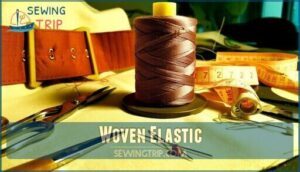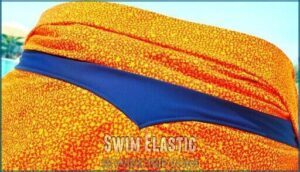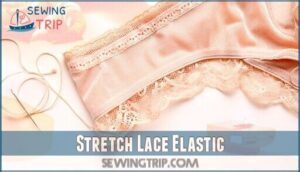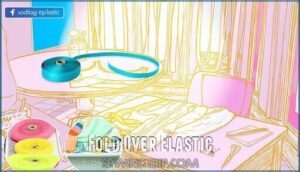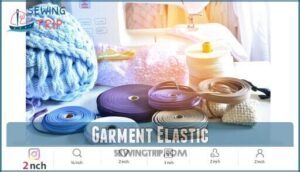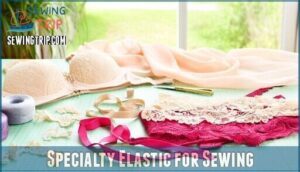This site is supported by our readers. We may earn a commission, at no cost to you, if you purchase through links.
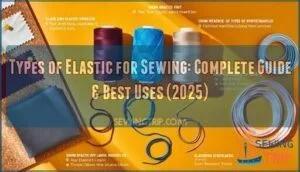
Braided elastic narrows when stretched, making it perfect for lightweight fabric casings like pajama pants or masks.
Knit elastic maintains its width under tension, providing comfortable waistbands that won’t dig in.
Woven elastic offers maximum durability for heavy-duty applications like jeans or upholstery projects.
Beyond these basics, specialty elastics solve specific problems: swim-resistant types handle chlorine, clear elastic provides invisible support, and fold-over elastic creates professional edge finishes.
Understanding which elastic matches your fabric weight and intended use prevents common mistakes that leave you with uncomfortable, rolling waistbands or failed seams.
Table Of Contents
Key Takeaways
- Match elastic type to your project needs – you’ll want braided for lightweight casings, knit for comfortable waistbands that won’t dig in, and woven for heavy-duty applications that need maximum strength.
- Consider fabric weight when selecting elastic – lightweight fabrics work best with braided elastic, while heavy materials like denim require woven elastic to prevent failure and maintain durability.
- Use specialty elastics for specific challenges – you’ll find swim-resistant types handle chlorine exposure, clear elastic provides invisible support, and fold-over elastic creates professional edge finishes.
- Prevent common mistakes by understanding elastic behavior – braided elastic narrows when stretched (avoid for exposed waistbands), knit elastic maintains width under tension, and choosing the wrong type leads to rolling waistbands or failed seams.
Braided Elastic
Braided elastic consistently delivers maximum stretch when you need flexibility in lightweight garments.
When flexibility matters most, braided elastic delivers the stretch you need
This distinctive ribbed elastic narrows when stretched, making it perfect for casing applications rather than direct sewing.
You’ll find braided elastic ideal for mask sewing, swimwear necklines, and delicate fabric hems.
While braided durability doesn’t match woven types, it offers excellent stretch limitations for projects requiring significant give.
Choose this elastic type when working with soft materials that need gentle, accommodating stretch without the bulk of heavier sewing elastic types.
Knit Elastic
Choosing knit elastic for your projects means you’ll get comfort that doesn’t compromise on durability.
This stretchy elastic maintains its width when stretched, making it perfect for waistbands and cuffs where consistent fit matters most.
Here’s why knit elastic stands out among elastic types:
- Superior comfort – The knitted construction feels soft against skin, ideal for children’s clothing and activewear
- Reliable performance – Won’t narrow under tension like braided options, ensuring your garments keep their shape
- Versatile applications – Works well sewn directly onto fabric or threaded through casings
You’ll find knitted elastic particularly valuable for sewing techniques requiring exposed waistbands or leg bands.
When sewing, remember to use a stretch needle to avoid damaging the elastic.
Woven Elastic
Think of woven elastic as the workhorse of your sewing toolkit. This sturdy elastic features interlaced fibers that create exceptional woven durability, making it perfect for heavy fabrics and demanding applications.
You’ll find it maintains its width when stretched and won’t roll or twist like other elastic types. Woven elastic excels in waistband strength for pants and skirts, belt applications, and home decor projects like cushion covers.
Its firm structure handles repeated washing and wear without losing elasticity, making it ideal when you need reliable performance over time. For best results, consider stabilizing lighter fabrics with interfacing.
Specialty Elastics
When you need elastic for specific purposes beyond standard waistbands and hems, specialty elastics offer targeted solutions for unique sewing challenges.
These specialized options include swim-resistant varieties, decorative stretch laces, invisible clear elastic, and fold-over types designed for professional-looking finishes.
Swim Elastic
Swimwear elastic delivers superior chlorine resistance and seawater durability compared to standard options.
This specialized elastic maintains elasticity retention after repeated pool exposure while providing UV protection for your suits.
You’ll find swimwear elastic in widths from 1/4" to 1", perfect for leg openings and waistbands.
It guarantees suit comfort through countless swim sessions without degrading like regular elastic would.
Many retailers offer various swimwear elastics for different needs, providing countless swim sessions of comfort and seawater durability.
Stretch Lace Elastic
Adding stretch lace elastic to your sewing projects transforms ordinary garments into elegant, comfortable pieces. This specialty elastic combines nylon and spandex to create a decorative trim that stretches in multiple directions while maintaining its shape.
You’ll find stretch lace elastic particularly valuable for lingerie construction, where both function and aesthetics matter. The lace elastic applications span from underwear leg openings to waistband finishes, offering decorative lace sewing possibilities that elevate your handmade items.
When selecting stretch lace, consider these factors:
- Lace elastic durability varies substantially – quality brands maintain elasticity through hundreds of washes while budget options lose stretch quickly
- Stretch lace cost ranges from affordable basic trims to premium designer varieties with intricate patterns and metallic threading
- Best lace brands typically feature 8-15% elastane content for optimal recovery and longevity in finished garments
This elastic works beautifully for bra straps, underwear edges, and decorative accents where you need both stretch and visual appeal. For ideal results, remember to use a ballpoint sewing needle to prevent snags.
Clear Elastic
Clear elastic offers invisible support for your sewing projects, making it perfect when you don’t want visible seams.
This transparent elastic excels at:
- Seam stabilization in lightweight fabrics like chiffon or jersey knits
- Ruffle creation and gathering without adding bulk to delicate materials
You’ll find clear elastic particularly valuable for swimwear uses where traditional elastic might show through sheer fabrics, providing the stretch you need while maintaining a professional finish.
As it’s 100% polyurethane, clear elastic offers complete latex-free performance, which is ideal for those with sensitivities.
Fold Over Elastic
When you need to finish edges with a professional touch, fold over elastic (FOE) becomes your go-to solution.
This specialized elastic features a center groove that makes folding over fabric edges effortless, creating clean finishes on underwear, headbands, and activewear.
Available in various FOE widths from 15-22mm and countless FOE colors, this versatile elastic transforms raw edges into polished seams for any sewing project.
Garment Elastic
Garment elastic typically serves as the backbone of comfortable, well-fitting clothing across various sewing projects.
You’ll find elastic widths ranging from ⅛ inch to 2 inches, accommodating different fabric weights and garment requirements. Understanding elastic durability, comfort, and recovery properties helps you select the right type for your specific needs.
- Braided elastic works best in casings for lightweight fabrics, providing excellent elastic tension without rolling
- Knit elastic maintains width when stretched, offering superior elastic comfort for direct sewing applications
- Woven elastic delivers maximum elastic durability for heavy fabrics, ensuring consistent performance in demanding garments
Specialty Elastic for Sewing
You’ll find specialty elastics designed for specific sewing challenges that regular elastic can’t handle effectively.
These specialized options include fold-over elastic for clean finishes and lingerie elastic for delicate, decorative applications.
Fold-Over Elastic for Sewing
Fold-over elastic (FOE) stands out as one of the most versatile sewing supplies in your toolkit. This specialty elastic features a center crease that allows you to fold it perfectly over fabric edges, creating professional-looking finishes without bulk.
You’ll find FOE applications extending far beyond basic binding techniques, making it perfect for both functional and decorative uses in garments.
Here’s how you can put foldover elastic to work:
- Edge Finishes: Encase raw edges on necklines, armholes, and leg openings for a clean, stretchy seal
- Binding Techniques: Create comfortable waistbands that won’t dig in or roll over time
- Decorative Uses: Add colorful accents to children’s clothing, activewear, and swimwear edges
- Project Ideas: Make hair ties, headbands, and straps that stretch and recover beautifully
When sewing elastic like FOE, you’ll appreciate how it eliminates the need for hemming while providing superior stretch recovery. You can find a wide variety available online.
Lingerie Elastic for Sewing
Lingerie elastic transforms your delicate garments with specialized comfort and style. You’ll find widths from 6-12mm featuring soft plushback elastic that prevents skin irritation during extended wear.
Popular varieties include strap elastic with decorative applications like picot edging and lace edges that enhance your project’s aesthetics. When you’re sewing with elastic for lingerie, choose stretch lace options for beautiful decorative touches on bras and panties.
Apply lingerie elastic using zigzag stitches for flexibility and durability. This specialty elastic maintains its stretch through multiple wash cycles while providing gentle support.
You can source quality options from brands like Dritz and Stretchrite for professional results.
Frequently Asked Questions (FAQs)
What are the different types of elastic bands for sewing?
Looking to stretch your sewing skills?
You’ll find five main elastic types: woven (sturdy waistbands), knitted (comfortable, maintains width), braided (soft, narrows when stretched), clear (invisible straps), and fold-over (binding edges).
What are the different types of elastic?
You’ll find several types of elastic for your projects: woven elastic stays sturdy and maintains width.
Knitted elastic stretches comfortably without narrowing, braided elastic softens but narrows when stretched.
Clear elastic works invisibly.
Are there different types of elastics?
Yes, there are several types of elastic you can choose from.
Woven elastic stays strong and doesn’t narrow when stretched.
Knitted elastic is lightweight and comfortable.
Braided elastic is soft but narrows when pulled.
What type of elastic is best for waistbands?
Woven elastic works best for waistbands because it’s sturdy, maintains its width when stretched, and won’t narrow or lose elasticity when you sew through it repeatedly.
How much elastic do I need for waistbands?
Getting the right amount is like measuring twice, cutting once—you’ll need your waist measurement minus 2-4 inches.
Measure your natural waistline, subtract that amount for stretch, then add seam allowances for the perfect fit.
Can elastic be washed in hot water?
Hot water can damage most elastics, causing them to lose stretch and break down faster.
You’ll want to wash elastic in warm or cold water instead to preserve its elasticity and extend its lifespan.
What causes elastic to lose its stretch?
Heat, frequent stretching, age, and chemical exposure break down elastic fibers.
Hot water washing, chlorine from pools, and constant tension gradually weaken the rubber or spandex, causing permanent loss of stretch.
How do you prevent elastic from twisting?
To prevent elastic from twisting, mark one side with chalk or a safety pin before sewing.
Stitch carefully without stretching the elastic, and use a walking foot if available for even feeding through your machine.
Which elastic works best for heavy fabrics?
Like a sturdy anchor holding a ship against stormy seas, woven elastic grips heavy fabrics without budging.
You’ll want woven elastic—it’s stronger, doesn’t narrow when stretched, and won’t lose elasticity when stitched through thick materials.
Conclusion
Mastering the different types of elastic for sewing will revolutionize your garment construction forever.
Choose braided elastic for lightweight projects where slight narrowing won’t matter. Select knit elastic when you need consistent width and comfort against skin. Pick woven elastic for heavy-duty applications requiring maximum strength.
Match your elastic type to fabric weight and project demands. Remember that specialty elastics solve specific challenges like swimwear durability or invisible support.
The right elastic choice prevents common problems like rolling waistbands and guarantees professional results every time.
- https://www.craftsy.com/blog/2015/10/types-of-elastic-for-sewing/
- https://pinterest.com/pin/create/button/?url=https://www.allfreesewing.com/Basics-and-Tutorials/How-to-Sew-with-Elastic
- https://www.facebook.com/sharer/sharer.php?u=https://www.allfreesewing.com/Basics-and-Tutorials/How-to-Sew-with-Elastic
- https://www.prettyprudent.com/diy-buttonhole-elastic/
- https://shrsl.com/2fb21

